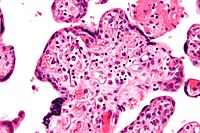
Photo from wikipedia
BackgroundWhile being small-for-gestational-age due to placental insufficiency is a major risk factor for stillbirth, 50% of stillbirths occur in appropriate-for-gestational-age (AGA, > 10th centile) fetuses. AGA fetuses are plausibly also at… Click to show full abstract
BackgroundWhile being small-for-gestational-age due to placental insufficiency is a major risk factor for stillbirth, 50% of stillbirths occur in appropriate-for-gestational-age (AGA, > 10th centile) fetuses. AGA fetuses are plausibly also at risk of stillbirth if placental insufficiency is present. Such fetuses may be expected to demonstrate declining growth trajectory across pregnancy, although they do not fall below the 10th centile before birth. We investigated whether reduced growth velocity in AGA fetuses is associated with antenatal, intrapartum and neonatal indicators of placental insufficiency.MethodsWe performed a prospective cohort study of 308 nulliparous women who subsequently gave birth to AGA infants. Ultrasound was utilised at 28 and 36 weeks’ gestation to determine estimated fetal weight (EFW) and abdominal circumference (AC). We correlated relative EFW and AC growth velocities with three clinical indicators of placental insufficiency, namely (1) fetal cerebroplacental ratio (CPR; CPR < 5th centile reflects placental resistance, and blood flow redistribution to the brain – a fetal response to hypoxia); (2) neonatal acidosis after the hypoxic challenge of labour (umbilical artery (UA) pH < 7.15 at birth); and (3) low neonatal body fat percentage (BF%, measured by air displacement plethysmography) reflecting reduced nutritional reserve in utero.ResultsFor each one centile reduction in EFW growth velocity between 28 and 36 weeks’ gestation, there was a 2.4% increase in the odds of cerebral redistribution (CPR < 5th centile, odds ratio (OR) (95% confidence interval) = 1.024 (1.005–1.042), P = 0.012) and neonatal acidosis (UA pH < 7.15, OR = 1.024 (1.003–1.046), P = 0.023), and a 3.3% increase in the odds of low BF% (OR = 1.033 (1.001–1.067), P = 0.047). A decline in EFW of > 30 centiles between 28 and 36 weeks (compared to greater relative growth) was associated with cerebral redistribution (CPR < 5th centile relative risk (RR) = 2.80 (1.25–6.25), P = 0.026), and a decline of > 35 centiles was associated with neonatal acidosis (UA pH < 7.15 RR = 3.51 (1.40–8.77), P = 0.030). Similar associations were identified between low AC growth velocity and clinical indicators of placental insufficiency.ConclusionsReduced growth velocity between 28 and 36 weeks’ gestation among fetuses born AGA is associated with antenatal, intrapartum and neonatal indicators of placental insufficiency. These fetuses potentially represent an important unrecognised cohort at increased risk of stillbirth and may warrant more intensive antenatal surveillance.
Journal Title: BMC Medicine
Year Published: 2017
Link to full text (if available)
Share on Social Media: Sign Up to like & get
recommendations!